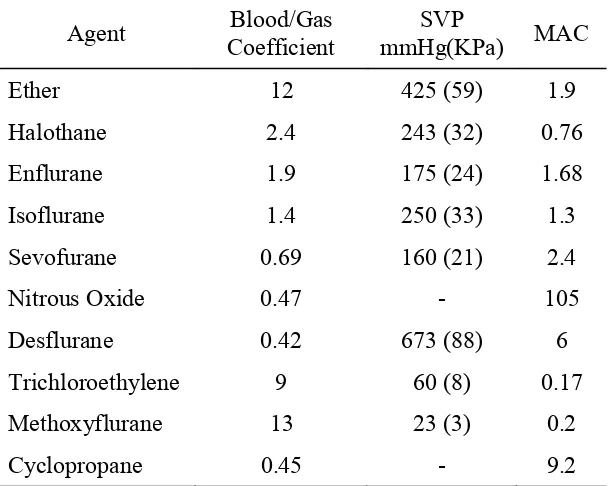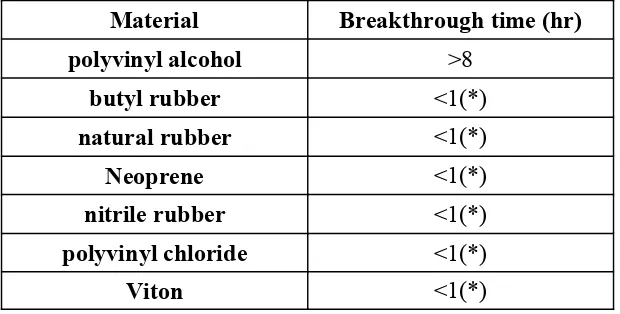10 CHAPTER 2
LITERATURE REVIEW
2.1Anaesthethics
2.1.1 Definition of anesthetic
Anesthesia is used in surgery to minimize pain, discomfort, and shock for surgical patients. When anesthesia works as expected, the patient feels no pain during a procedure, and often does not remember the proceedings either. Anesthesia increases patient comfort, which can in turn reduce recovery times. With the knowledge that they are not inflicting pain, it also makes it easier for a medical staff to work.1
There are three different types of anesthesia; local anesthesia, regional anesthesia and general anesthesia. In local anesthesia a specific location of the body is numbed, such as the hand. Regional anesthesia numbs a larger area of the body by administering anesthesia to a cluster of nerves. Two frequently used regional anesthesia are spinal anesthesia and epidural anesthesia. General anesthesia describes unconsciousness and lack of any awareness or sensation. 1
2.1.2 Mechanism of anesthetic
11
of the body (lipid solubility) as determining the degree of its potency as an anesthetic agent. Another feature of anesthetic absorption is the way it is passed from the lungs to other cells in the body. At first there is a quick transmission from the lungs to the rest of the body, but as equilibrium is reached, the anesthetic begins to quickly pass out from the lungs. However, fat cells retain the anesthetic longer than other cells. Studies have shown that some inhaled anesthetics are metabolized by the liver (hepatic metabolism).
The mechanism of anesthesia is closely related to the problem of consciousness. Consciousness is caused by many interacting mechanisms, each in itself or in interaction with other mechanisms sufficient to create consciousness. Is it the degeneracy character of the neural mechanisms causing consciousness the reason for the difficulties to define its neuronal correlate.21
2.2Inhalation Anesthetics
2.2.1 Definition of inhalation anesthetic
Inhalation anesthetics are gases that possess anesthetic qualities that are administered by breathing through an anesthesia mask or ET tube connected to an anesthetic machine.2
12
tissues. The main target of inhalation anesthetics (or so-called volatile anesthetics) is the brain.22
2.2.2 The types of inhalation anesthetics
Inhalational anesthetic agents include nitrous oxide and the volatile agents such as ether, chloroform, halothane, isoflurane, enflurane, methoxyflurane, sevoflurane, desflurane, cyclopropane and trichloroethylene (trilene).
Table 2. Comparation value among inhalation anesthetics agent
Agent Blood/Gas
SVP mmHg (Kpa) : Saturated Vapor Pressure
13
2.3The Toxic Effects of Inhalation Anesthetics
The three target organs for toxicity of inhalation agents are the liver, the kidney, and the blood cell.
2.3.1 Liver
Fulminant hepatic necrosis following halothane anesthesia (halothane hepatitis) occurs in one of 6,000 to 35,000 cases and is often fatal. Halothane hepatitis is probably caused by trifluoroacetyl-containing metabolites binding to protein and subsequently forming anti-trifluoroacetyl protein antibodies. During re-exposure of the patient with halothane these antibodies may mediate massive hepatic necrosis.
2.3.2 Kidney
Nephrotoxicity in the earlier years was mainly caused by methoxyflurane. It caused high output renal failure with elevation of serum creatinine and BUN. It was related to the metabolism of methoxyflurane possibly releasing inorganic fluorides. Toxicity started to occur at peak fluoride levels of 50 to 80 mM and was evident at levels of 80 to 175 mM. The threshold of 50 mM was subsequently selected to be the magic number for renal toxicity.
2.3.3 Red blood cells
14
isoflurane. This occurs usually on Monday mornings after the anesthesia machine had been idle with fresh gas flow all weekend resulting in dry CO2 absorbents.6
2.4Halothane (Field of study) 2.4.1 Definition
Halothane, USP is supplied as a liquid and is vaporized for use as an inhalation anesthetic. It is 2-bromo-2-chloro-1, 1, 1-trifluoro-ethane. C2HBrClF3 The molecular weight is 197.38. The drug substance halothane molecule has an asymmetric carbon atom; the commercial product is a racemic mixture. In another name of halothane is fluothane.
15
Fluothane vapor or liquid. Stability of Fluothane is maintained by the addition of 0.01% thymol (w/w), up to 0.00025% ammonia .
According to the Serbian legislation the threshold limit value (TLV) for halothane is 40 mg/m3 (4.9 ppm). Halothane has quite low TLV, ranging from 0.5 ppm (Australia) to 5 ppm (Sweden and Germany). The National Institute for Occupational Safety and Health (NIOSH) has established a recommended exposure limit (REL) of 2 ppm (16.2 mg/m3) for halothane (as a waste anesthetic gas) as a 60-minute ceiling limit that should not be exceeded during any part of the workday. The American Conference of Governmental Industrial Hygienists (ACGIH) has assigned halothane a TLV of 50 ppm (404 mg/m3) as a time-weighted average (TWA) for a normal 8-hour workday and a 40-hour work week.22
Figure 1. Structure of Halothane
2.4.2 Mechanism of halothane
Halothane may be administered by the nonrebreathing technique, partial rebreathing, or closed technique. The induction dose varies from patient to patient but is usually within the range of 0.5% to 3%. The maintenance dose varies from 0.5% to 1.5%. Fluothane may be administered with either oxygen or a mixture of oxygen and nitrous oxide.
16
Fluothane should not be kept indefinitely in vaporizer bottles not specifically designed for its use. Thymol does not volatilize along with Fluothane and, therefore, accumulates in the vaporizer and may, in time, impart a yellow color to the remaining liquid or to wicks in vaporizers. The development of such discoloration may be used as an indicator that the vaporizer should be drained and cleaned, and the discolored Fluothane (halothane, USP) discarded. Accumulation of thymol may be removed by washing with diethyl ether. After cleaning a wick or vaporizer, make certain all the diethyl ether has been removed before reusing the equipment to avoid introducing ether into the system.
2.4.3 Advantages and Disadvantages of Halothane 2.4.3.1Overview:
a. Halothane causes unconsciousness; however, does not provide adequate analgesia.
b. Halothane (Fluothane) may not adequately suppress visceral reflexes or provide adequate muscle relaxation for surgery.
c. Halothane (Fluothane) is associated with reversible reduction in glomerular filtration rates (GFR).
2.4.3.2Halothane Advantages:
a. Halothane (Fluothane) is relatively potent and is nonflammable. b. This drug's low blood: gas partition coefficient explains both
17
c. Halothane (Fluothane) can be used to provide controlled hypotension to reduce/manage bleeding.
2.4.3.3Halothane Disadvantages
a. Halothane (Fluothane) is associated with unpredictable hepatitis occurrences.
b. Significant myocardial depression is observed with halothane (Fluothane). 13
2.4.4 Clinical Indication & System Physiology
Halothane (Fluothane) is effective for general anesthetic maintenance and may be an induction agent of choice in difficult airway
Systems Physiology: a. CNS:
1) Generalized CNS depression
2) cerebrovascular dilation causes increased ICP b. Cardiovascular:
1) Halothane (Fluothane) causes a slight decrease in heart rate, a decrease in mean arterial pressure (MAP)-- both associated with its well-documented cardiac depressant property.
18 c. Pulmonary:
1) Halothane (Fluothane) causes decreasing tidal volume with increasing MAC, increasing respiratory rate with increasing MAC 2) Halothane (Fluothane) also promote significant bronchodilation
d. Hepatic:
Fulminant hepatic failure (halothane hepatitis): Case history for slides below: "Forty four year old lady had uterine curettage for metrorrhagia. Eight weeks later she had hysterectomy. Three days after hysterectomy she became jaundiced. Seven days later she died in liver failure. Halothane was used as anesthetic in both surgical procedures. The autopsy showed massive liver necrosis. It appears that the liver damage was mediated by an immunoreactive mechanism. Multiple exposures increase the incidence of liver damage.25
e. Mechanism of Hepatotoxicity of halothane
19
ability to acetylate liver proteins, is formed during the synthesis of trifluoroacetic acid. Only a small amount (~%1) of halothane is metabolized through the reductive pathway by cytochrome P450 2A6 and 3A4. This pathway is favored under hypoxic conditions, resulting in the release of bromide and fluoride ions and in the formation of other volatile organic metabolites.22 The release of these ions damage membrane integrity of cells and results in fatty change, acute yellow atrophy and widespread nucleus changes (e.g, enlarge, karyorhexis, karyolisis nucleus) that is indistinguishable from fulminant viral hepatitis.
20
combination with local hypoxia caused by an alteration of the hepatic oxygen demand and supply relationship. The second type of halothane-mediated hepatotoxicity is type II-halothane hepatitis. The incidence of this type of hepatotoxicity after halothane administration is one case per 10000-30000 adult patients. The probable mechanism is most likely an immune-mediated hepatotoxicity; antibodies are against modified liver microsomal proteins on hepatocyte surfaces.6
21
There has no data yet showing that this changes are reversible. Adverse reverse prognostic factors include: serum bilirubin >20 mg/dLb, coagulopathy, older age (> 40 years), obesity, and short duration interval to onset of jaundice.21, 28
1. Type I (mild) halothane hepatotoxicity
a. Type I occurs within hours of halothane exposure. b. It does not occur after other agents.
c. Type I is characterized by mild, transient elevations in serum transaminase and glutathione S- transferase concentrations.
d. Jaundice is not observed, and no evidence of hepatocellular disease is present.
2. Type II (fulminant) halothane hepatotoxicity
a. Type II usually occurs 5-7 days following exposure, although it can be delayed by up to 4 weeks.
b. Fever, leukocytosis, and eosinophilia are observed. c. Nonspecific gastrointestinal upset may be noted. d. Nausea and vomiting may occur.
e. Patients may report arthralgias.
f. Most prominently, the patient looks and feels unwell. g. Fulminant liver failure may ensue.
22
including other hepatotoxic medications, hypotension, hypoxia, and infection.
The phenotype can be distinguished by the actual activity or the amount of the expressed CYP enzyme. The genotype, however, is determined by the individual DNA sequence. Since human has two sets of chromosomes, that mean the same genotype enables different phenotypes. Depending on the metabolic activity (phenotype), three major cathegories of metabolizers are separated: extensive metabolizer (normal), poor metabolizer, and ultra-rapid metabolizer (increased metabolism of xenobiotics). However, until recently there is no published evidence of CYP2E1, CYP2A6, and CYP3A4 genetic polymorfism that correlate with halothane metabolism.29
23 2.5 Balb/C Mouse
The Balb/c mouse originated in 1923 by McDowell. It is a popular strain and is used in many different research disciplines, but most often in the production of monoclonal antibodies. BALB/c mice are particularly well known for the production of plasmacytomas following injection with mineral oil, forming the basis for the production of monoclonal antibodies .32
Also classified as an inbred from the production of 20 or more successive brother-sister mating, the Balb/c mouse is albino and small in size.
Strain characteristics related to the Balb/c mouse include: Low alcohol preference
Low incidence of mammary tumors
Resistance to atherosclerosis development when fed an atherogenic diet. High incidence of cardiac calcification, especially in males.
Overall higher incidence of heart defects and spontaneous myocardial lesions of the right ventricle.
Generally good breeding performance, with low incidence of barbering. Sensitivity to radiation.
Low incidence of ovarian cysts.
24 2.6 Personal Protective Equipment
Workers should use appropriate personal protective clothing and equipment that must be carefully selected, used, and maintained to be effective in preventing skin contact with halothane. The selection of the appropriate personal protective equipment (PPE) (e.g., gloves, sleeves, encapsulating suits) should be based on the extent of the worker's potential exposure to halothane. The resistance of a protective material to permeation by halothane is shown below:
Table 3. The resistance of a protective material to permeation by halothane
Materials with breakthrough times of <1 hr are not recommended for use against halothane.
Any chemical-resistant clothing that is used should be periodically evaluated to determine its effectiveness in preventing dermal contact. Safety showers and eye wash stations should be located close to operations that involve halothane. Splash-proof chemical safety goggles or face shields (20 to
Material Breakthrough time (hr)
polyvinyl alcohol >8
butyl rubber <1(*)
natural rubber <1(*)
Neoprene <1(*)
nitrile rubber <1(*)
polyvinyl chloride <1(*)
25
30 cm long, minimum) should be worn during any operation in which a solvent, caustic, or other toxic substance may be splashed into the eyes.

